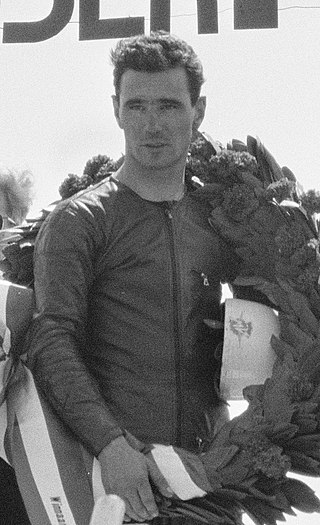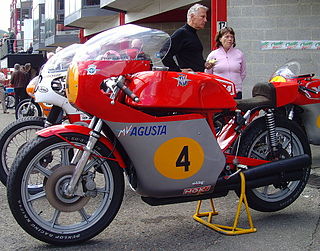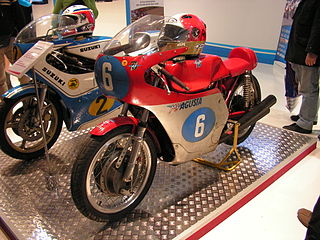
MV Agusta is a high end motorcycle manufacturer founded by Count Domenico Agusta on 19 January 1945 as one of the branches of the Agusta aircraft company near Milan in Cascina Costa, Italy. The abbreviation MV stands for Meccanica (mechanics) Verghera, the hamlet where the first MVs were made. The modern headquarters and main production facilities are located in Varese, Italy on the shore of Lake Varese.

Giacomo Agostini is an Italian former Grand Prix motorcycle road racer. Nicknamed Ago, he amassed 122 Grand Prix wins and 15 World Championship titles. Of these, 68 wins and 8 titles came in the 500 cc class, the rest in the 350 cc class. For these achievements obtained over the course of a career spanning 17 years, the AMA described him as "...perhaps the greatest Grand Prix rider of all time". In 2000, Agostini was inducted into the MotoGP Hall of Fame as a MotoGP Legend, while in 2010, he was named an FIM Legend for his motorcycling achievements.

FB Mondial is a motorcycle manufacturer, founded in 1929, in Milan, Italy. They are best known for their domination of Motorcycle World Championships between 1949 and 1957. The firm produced some of the most advanced and successful Grand Prix road racers of the time, winning five rider and five manufacturer World Championships in that short period.

Gary Stuart Hocking MBE was a Grand Prix motorcycle racing world champion who competed in the late 1950s and early 1960s based in Rhodesia.

Phillip William Read, was an English professional motorcycle racer. He competed in Grand Prix motorcycle racing from 1961 to 1976. Read is notable for being the first competitor to win world championships in the 125 cc, 250 cc and 500 cc classes. Although he was often overshadowed by his contemporary, Mike Hailwood, he won seven FIM Grand Prix road racing world championships.

Carlo Ubbiali was an Italian nine-time World Champion motorcycle road racer. In the 1950s, he was a dominant force in the smaller classes of Grand Prix motorcycle racing, winning six 125cc and three 250cc world titles.
Robert Leslie Graham was a British motorcycle road racer who competed in the 1930s and 1940s. He won the inaugural Grand Prix motorcycle racing 500 cc World Championship in 1949.
The 1957 Isle of Man Tourist Trophy was the Golden Jubilee event and the second race in the 1957 Motorcycle World Championships.

Robert MacGregor McIntyre was a Scottish motorcycle racer. The first rider to achieve an average speed of 100 mph (160 km/h) for one lap of the Snaefell Mountain Course in 1957, McIntyre is also remembered for his five motorcycle Grand Prix wins which included three wins at the Isle of Man TT races, and four victories in the North West 200. He died nine days after injuries sustained racing at Oulton Park, Cheshire, England in August 1962.

Tarquinio Provini was an Italian professional Grand Prix motorcycle road racer. He was a two-time world champion in road racing. Provini was also a four-time Isle of Man TT winner and won 13 Italian national championships.
Cecil Charles Sandford is a British former professional Grand Prix motorcycle road racer. He competed in the FIM motorcycle Grand Prix world championships from 1950 to 1957. Sandford is a two-time FIM road racing world champion and a two-time winner at the Isle of Man TT.

The MV Agusta 500cc Three (1965–1973) or MV Agusta Tre was a road racing motorcycle produced by the Italian manufacturer MV Agusta to compete in the 500 cc Grand Prix motorcycle racing World Championship. The motorcycle was introduced in 1966 to compete against the ever competitive Honda racing machines and was a bored out version of MV Agusta's highly successful 350 cc three cylinder. Giacomo Agostini won consecutive world championships in the 500 cc class with this motorbike from 1966 to 1972. In addition, MV Agusta won the Constructors' World Championships from 1967 to 1972. The MV Agusta Tre is considered the most successful racing motorcycle in history.

The MV Agusta 500cc road racers were motorcycles that the manufacturer MV Agusta built and which were used to compete in 500cc Grand Prix motorcycle racing series between 1950 and 1976. 18 500cc world championship titles were achieved with these machines ridden by John Surtees, Gary Hocking, Mike Hailwood, Giacomo Agostini and Phil Read between 1958 and 1974.

The MV Agusta 350 cc racers were motorcycles produced by MV Agusta between 1954 and 1976 and raced in the 350 cc motorcycle GP championships. 10 world titles were achieved by riders John Surtees, Gary Hocking and Giacomo Agostini on these machines.

The MV Agusta 350 6 cilindri was a prototype racing motorcycle built by the Varese company MV Agusta in 1957, for the 350 cc class of the FIM Motorcycle World Championship. The project was resurrected in 1968. Neither version was ever used in a race. The only surviving model is now in the MV Agusta factory museum.
The MV Agusta 250 Monocilindrica Bialbero was a 250 cc factory racer manufactured by the Italian brand MV Agusta from 1956 to 1959. With this machine 15 GPs, 2 Driver Championships and 2 manufacturers World Championships were won.
The MV Agusta 203 Bialbero and MV Agusta 220 Bialbero were Italian factory racing motorcycles made by MV Agusta to compete in the 1955 250 cc World Motorcycle Racing Championship. The machine won three GPs and with it MV Agusta won that year's 250 cc Constructors Championship.

The MV Agusta 125 Bialbero was a 125 cc factory racer from the Italian brand MV Agusta, which was used between 1950 and 1960. The machine won 34 GPs, 6 rider's championships and one manufacturer's championship. The machine also won 4 Italian Championships and 10 National Championships in other countries.
Arturo Magni was an Italian engineer racing team manager and entrepreneur.
Piero Remor was an Italian engineer and motorcycle constructor, best known for his work for the Gilera and MV Agusta brands.












